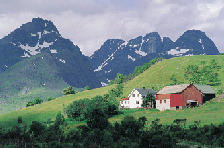Norwegian agriculture
Historical archive
Published under: Bondevik's 1st Government
Publisher: Ministry of Agriculture
Guidelines/brochures | Date: 04/02/2000
Norwegian agriculture
Norway is the northernmost country in Europe. Its mainland extends from 58 to 71 degrees North, a total distance of about 1 750 km, greater than the distance between Oslo and Rome. The country's population density is only 13 people/km2, the second lowest in Europe (only Iceland has a lower density).
 The main productions are dairy and meat products, cereals and
temperate fruits and vegetables. About three quarters of farm
income is derived from livestock production and one quarter from
crop production. The production is almost entirely destined for the
national market and plays an important role in ensuring national
food security, sustaining the viability of rural areas and
safeguarding certain environmental qualities.
The main productions are dairy and meat products, cereals and
temperate fruits and vegetables. About three quarters of farm
income is derived from livestock production and one quarter from
crop production. The production is almost entirely destined for the
national market and plays an important role in ensuring national
food security, sustaining the viability of rural areas and
safeguarding certain environmental qualities.
Arable land represents only 3% of the total area in Norway. The average farm size is around 12ha arable land. The average field size is only 1.5 ha, and nearly 20 per cent of the agricultural area have a gradient exceeding 1:5. Dairy farms have an average herd of 12 cows. The arctic and subartic conditions in Norway are characterised by harsh climate, low temperatures and a short growing season, which varies between 100 and 190 days, depending to a large extent on latitude. The indoor period for livestock varies from around 230 to 290 days a year. All the disadvantages stemming from a harsh climate, long distances, a difficult topography, a low population density and a small-scale structure result in very high costs and a very low degree of competitiveness at world market prices.